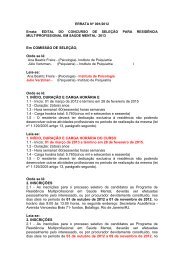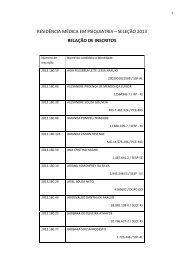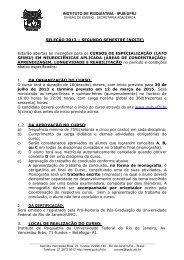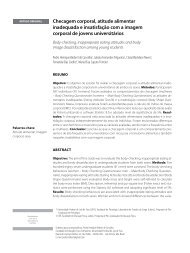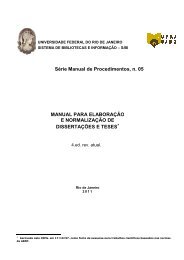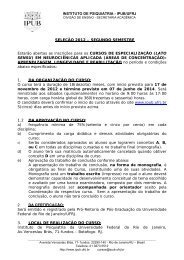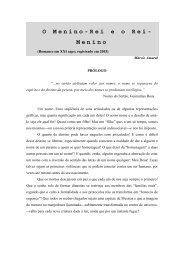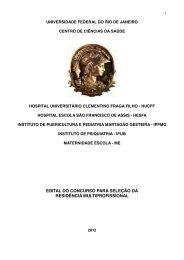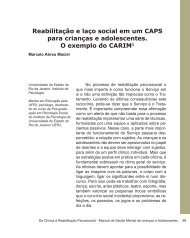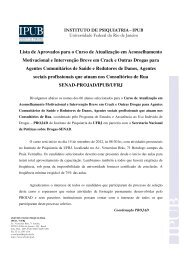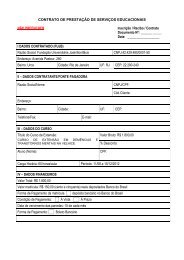Originais â Originals outubro | dezembro ⢠2011 - IPUB - UFRJ
Originais â Originals outubro | dezembro ⢠2011 - IPUB - UFRJ
Originais â Originals outubro | dezembro ⢠2011 - IPUB - UFRJ
Create successful ePaper yourself
Turn your PDF publications into a flip-book with our unique Google optimized e-Paper software.
evisão de literatura<br />
A patogênese da síndrome de Angelman<br />
329<br />
dos últimos dez anos. Além desses, alguns outros trabalhos<br />
foram citados, por sua relevância para a discussão do tema.<br />
RESULTADOS<br />
Utilizando “Angelman syndrome” na busca, apareceram cerca<br />
de 1.100 artigos, incluindo 240 de revisão. Nos últimos dez<br />
anos, são mais de 600 artigos, aproximadamente 120 de revisão,<br />
50% dos quais publicados nos últimos cinco anos. Na<br />
base de dados SciELO, são apenas nove artigos sobre a síndrome,<br />
dos quais três em português e nenhum artigo atual<br />
de revisão. Conforme explicado em métodos, a escolha dos<br />
artigos utilizados nesta revisão foi feita pelos autores. A presente<br />
revisão não é exaustiva quanto a todas as mutações<br />
encontradas no gene UBE3A e nem quanto a todos os substratos<br />
encontrados para UBE3A. Foram incluídos e discutidos<br />
os substratos para os quais pode haver uma correlação<br />
com a fisiopatologia dos afetados, um destaque que não é<br />
exclusividade dos presentes autores. As figuras foram incluídas<br />
pelo seu poder de ilustrar e tornar mais compreensível<br />
a parte genética do artigo. A fotografia dos dendritos com<br />
suas espículas sinápticas explica o que palavras são pobres<br />
para explicar. Nos últimos dois anos, a disfunção de algumas<br />
condições clínicas de deficiência intelectual está sendo traçada<br />
para a sinapse e está servindo para esclarecer muitos<br />
pontos desconhecidos da formação, modulação e manutenção<br />
delas.<br />
CONCLUSÃO<br />
Após ter sido uma das principais causas para o estudo mais<br />
aprofundado dos mecanismos do imprinting genômico, a<br />
síndrome de Angelman está se revelando como uma patologia<br />
das sinapses. A utilização de modelos animais para a<br />
síndrome de Angelman e a possibilidade de cultivar células<br />
deficientes na expressão materna de UBE3A estão levando<br />
ao reconhecimento de proteínas cuja degradação é comprometida<br />
nessas células, permitindo estudar sua expressão,<br />
localização e função, assim como as alterações micromorfológicas<br />
apresentadas pelos neurônios afetados. Apesar de<br />
o conhecimento da fisiopatologia molecular da síndrome<br />
de Angelman ser muito recente, e seu entendimento estar<br />
apenas começando a ser desvendado, seu estudo está fornecendo<br />
uma visão extraordinária sobre os mecanismos que<br />
regem a plasticidade sináptica.<br />
REFERÊNCIAS<br />
1. Williams CA, Zori RT, Stone JW, Gray BA, Cantu ES, Ostrer H. Maternal origin of 15q11-13<br />
deletions in Angelman syndrome suggests a role for genomic imprinting. Am J Med Genet.<br />
1990;35(3):350-3.<br />
2. Clayton-Smith J, Laan L. Angelman syndrome: a review of the clinical and genetic aspects.<br />
J Med Genet. 2003;40(2):87-95.<br />
3. Fridman C, Kok F, Diament A, Koiffmann CP. Angelman syndrome: a frequently undiagnosed<br />
cause of mental retardation and epilepsy [case report]. Arq Neuropsiquiatr.<br />
1997;55(2):329-33.<br />
4. Ohta T, Gray TA, Rogan PK, Buiting K, Gabriel JM, Saitoh S, et al. Imprinting-mutation mechanisms<br />
in Prader-Willi syndrome. Am J Hum Genet. 1999;64(2):397-413.<br />
5. Cook Jr EH, Lindgren V, Leventhal BL, Courchesne R, Lincoln A, Shulman C, et al. Autism<br />
or atypical autism in maternally but not paternally derived proximal 15q duplication. Am J<br />
Hum Genet. 1997;60(4):928-34.<br />
6. Christian SL, Brune CW, Sudi J, Kumar RA, Liu S, Karamohamed S, et al. Novel submicroscopic<br />
chromosomal abnormalities detected in autism spectrum disorder. Biol Psychiatry.<br />
2008;63(12):1111-7.<br />
7. Leitner RP, Smith A. An Angelman syndrome clinic: report on 24 patients. J Paediatr Child<br />
Health. 1996;32(2):94-8.<br />
8. Kara B, Karaman B, Ozmen M, Rosti RO, Caliskan M, Kayserili H, et al. Angelman syndrome:<br />
clinical findings and follow-up data of 14 patients. Turk J Pediatr. 2008;50(2):137-42.<br />
9. Schalock RL, Luckasson RA, Shogren KA, Borthwick-Duffy S, Bradley V, Buntinx WH, et al.<br />
The renaming of mental retardation: understanding the change to the term intellectual<br />
disability. Intellect Dev Disabil. 2007;45(2):116-24.<br />
10. Philippart M. Rett and Angelman’s syndromes: models of arrested development. Pediatr<br />
Neurol. 2001;25(4):288-94.<br />
11. Walz NC, Beebe D, Byars K. Sleep in individuals with Angelman syndrome: parent perceptions<br />
of patterns and problems. Am J Ment Retard. 2005;110(4):243-52.<br />
12. Guerrini R, Carrozzo R, Rinaldi R, Bonanni P. Angelman syndrome: etiology, clinical features,<br />
diagnosis, and management of symptoms. Paediatr Drugs. 2003;5(10):647-61.<br />
13. Peters SU, Goddard-Finegold J, Beaudet AL, Madduri N, Turcich M, Bacino CA. Cognitive<br />
and adaptive behavior profiles of children with Angelman syndrome. Am J Med Genet A.<br />
2004;128A(2):110-3.<br />
14. Summers JA, Feldman MA. Distinctive pattern of behavioral functioning in Angelman syndrome.<br />
Am J Ment Retard. 1999;104(4):376-84.<br />
15. Summers JA, Allison DB, Lynch PS, Sandler L. Behaviour problems in Angelman syndrome.<br />
J Intellect Disabil Res. 1995;39(Pt 2):97-106.<br />
16. Ruggieri M, McShane MA. Parental view of epilepsy in Angelman syndrome: a questionnaire<br />
study. Arch Dis Child. 1998;79(5):423-6.<br />
17. Lossie AC, Driscoll DJ. Transmission of Angelman syndrome by an affected mother. Genet<br />
Med. 1999;1(6):262-6.<br />
18. Lossie AC, Whitney MM, Amidon D, Dong HJ, Chen P, Theriaque D, et al. Distinct phenotypes<br />
distinguish the molecular classes of Angelman syndrome. J Med Genet. 2001;38(12):834-45.<br />
19. Lee ST, Nicholls RD, Jong MT, Fukai K, Spritz RA. Organization and sequence of the human P<br />
gene and identification of a new family of transport proteins. Genomics. 1995;26(2):354-63.<br />
20. Walz NC. Parent report of stereotyped behaviors, social interaction, and developmental disturbances<br />
in individuals with Angelman syndrome. J Autism Dev Disord. 2007;37(5):940-7.<br />
21. Volkmar FR, Lord C, Bailey A, Schultz RT, Klin A. Autism and pervasive developmental disorders.<br />
J Child Psychol Psychiatry. 2004;45(1):135-70.<br />
22. Trillingsgaard A, Østergaard JR. Autism in Angelman syndrome: an exploration of comorbidity.<br />
Autism. 2004;8(2):163-74.<br />
23. Huibregtse JM, Scheffner M, Beaudenon S, Howley PM. A family of proteins structurally<br />
and functionally related to the E6-AP ubiquitin-protein ligase. Proc Natl Acad Sci U S A.<br />
1995;92(7):2563-7.<br />
24. Jentsch S. The ubiquitin-conjugation system. Annu Rev Genet. 1992;26:179-207.<br />
25. Hershko A, Ciechanover A. The ubiquitin system for protein degradation. Annu Rev Biochem.<br />
1992;61:761-807.<br />
26. Scheffner M, Nuber U, Huibregtse JM. Protein ubiquitination involving an E1-E2-E3 enzyme<br />
ubiquitin thioester cascade. Nature. 1995;373(6509):81-3.<br />
27. Schwarz SE, Rosa JL, Scheffner M. Characterization of human hect domain family members<br />
and their interaction with UbcH5 and UbcH7. J Biol Chem. 1998;273(20):12148-54.<br />
28. Nawaz Z, Lonard DM, Smith CL, Lev-Lehman E, Tsai SY, Tsai MJ, et al. The Angelman<br />
syndrome-associated protein, E6-AP, is a coactivator for the nuclear hormone receptor<br />
superfamily. Mol Cell Biol. 1999;19(2):1182-9.<br />
J Bras Psiquiatr. <strong>2011</strong>;60(4):321-30.




